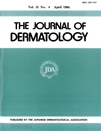A Case of Chronic GVHD Following Bone Marrow Transplantation from a Phenotypically HLA-Matched Unrelated Donor
Abstract
A 45-year-old male with chronic myelocytic leukemia who received a bone marrow transplantation from a phenotypically HLA-matched unrelated donor developed chronic GVHD on day 100 post transplantation. He developed a slight fever, malaise, hepatic dysfunction and extensive itchy erythema with scaling over his entire body. The inflammatory skin lesion developed into erythroderma in about two weeks. H&E staining of a skin biopsy revealed eosinophilic bodies and a lymphocytic infiltration in the dermis and epidermis, which were compatible with the early phases of chronic GVHD. Immunohistochemistry revealed that keratinocytes expressed dense HLA-DR and ICAM-1 epitopes. Langerhans cells (CD1a+ cells) had disappeared from the epidermis. Many T cells (CD3+ cells) had migrated into the epidermis as well as into the reticular dermis. The majority of the T cells in the epidermis were CD8+ cells, while almost all the T cells in the dermis were CD4+ cells. These immunohistochemical features were similar to those previously reported for acute cutaneous GVHD. Despite the corticosteroid therapy, the eruptions did not disappear. The patient was then treated with whole body bath-methoxsalen (Oxsoralen®) plus ultraviolet A (UVA). The bath-psoralen plus UVA therapy was effective in this patient.




